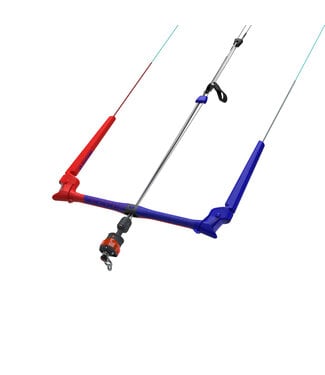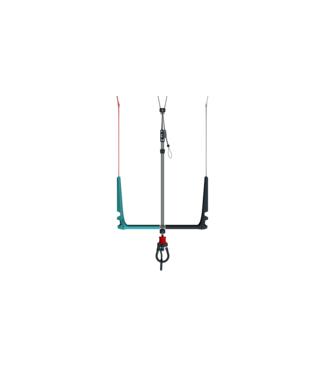Kitesurf bars, also called control bars, are a crucial part of kitesurfing equipment, as they connect the kite to the rider and allow control over the kite's movements. There are several important differences between kitesurf bars, and these differences can affect the performance and handling of the kite. Here are some common factors to consider:
Bar Length:
Longer bars typically provide more leverage and power, making it easier to control larger kites.
Shorter bars are generally used for smaller kites and can provide faster response times.
Adjustable vs. fixed bar ends:
Some bars have adjustable bar ends, allowing you to change the effective handlebar width. This can affect the responsiveness and power of the kite.
Depower system:
There are two main types of depower systems: Clamcleat and Power Bracket.
Clamcleat systems use a cleat to lock the depower line in place.
Power Bracket systems use a bracket that slides along the depower line to adjust power.
Chickenfinger :
The chicken finger is the part of the bar that attaches to the rider's harness.
Some bars have a fixed chicken finger, while others have a quick release mechanism for emergency situations.
Safety systems:
Modern kitesurf bars are equipped with various safety systems, such as quick-release mechanisms and safety leashes, to quickly and easily release the kite in emergency situations.
Above or below the bar Depower:
The depower adjustment system can be placed above or below the bar.
Over-the-bar systems are generally easier to access and adjust, while under-the-bar systems can provide a cleaner and less cluttered setup.
Marking line system:
This system determines how the kite flags out (loses power) in the event of an emergency release.
Some systems use a single frontline safety (SFS), while others use a fifth line or a hybrid system. Nowadays SFS/4 lines is the most used system.
Material and build quality:
The material and build quality of the bar can affect its durability and overall performance.
When choosing a kitesurf bar, it is important to consider your skill level, the type of kites you will use and your personal preferences for control and handling. It is also critical to follow the manufacturer's recommendations for the specific kite model you plan to use with the bar.
High or Low Split?
The terms "high split" and "low split" in the context of kite bars refer to the positioning of the front lines relative to the back lines on the bar. This configuration can affect the kite's performance, especially in terms of bar pressure, turning speed and depower.
High cleavage:
On a kite with a high split, the front lines are attached higher on the leading edge of the kite than the back lines. This setup usually results in a higher bar pressure, which means you feel more resistance when steering the kite. High split bars are often associated with more direct and responsive kite control. They can contribute to a faster and more crucial turning style.
Low split:
In a low split configuration, the leading lines are attached lower on the leading edge of the kite compared to the trailing lines. Low split bars generally offer lighter bar pressure, making it less tiring for the rider during longer sessions. This configuration often results in a more gradual and predictable turning style. Low split setups can provide a smoother and less aggressive feel, which may be preferred by riders who prioritize comfort and ease of use.
Choosing between a high split and low split kitebar often comes down to personal preference and riding style. Some riders prefer the direct and responsive feel of a high split bar for more aggressive and dynamic maneuvers, while others opt for a low split bar for a more relaxed and comfortable riding experience.
The specific characteristics of a kite are influenced by several factors, including the kite's design, shape and configuration. The choice of a high or low split bar is just one element in the overall setup that contributes to the kite's behavior in the air. Riders can experiment with different setups to find the bar/kite that best suits their preferences and riding style.
|
BAR/KITE CONNECTION |
|||||
|
KITE BRANDS |
KITE'S SIDE |
SPLIT |
|||
|
North |
knot |
walk |
walk |
knot |
V |
|
Eleveight |
knot |
walk |
walk |
knot |
V |
|
Spleene |
knot |
walk |
walk |
knot |
V |
|
ReedIn |
knot |
walk |
walk |
knot |
V |
|
Best |
knot |
walk |
walk |
knot |
V |
|
CrazyFly |
knot |
walk |
walk |
knot |
V |
|
Sling shot |
knot |
walk |
walk |
knot |
V |
|
Ocean Rodeo |
knot |
walk |
walk |
knot |
V |
|
Cabrinha |
knot |
walk |
walk |
knot |
V |
|
Duotone |
walk |
knot |
knot |
walk |
High V |
|
Naish |
walk |
knot |
knot |
walk |
V |
|
Ozone |
walk |
knot |
knot |
walk |
V |
|
Flysurfer |
knot |
knot |
knot |
knot |
V |
|
F-One |
knot |
knot |
knot |
knot |
High V |















